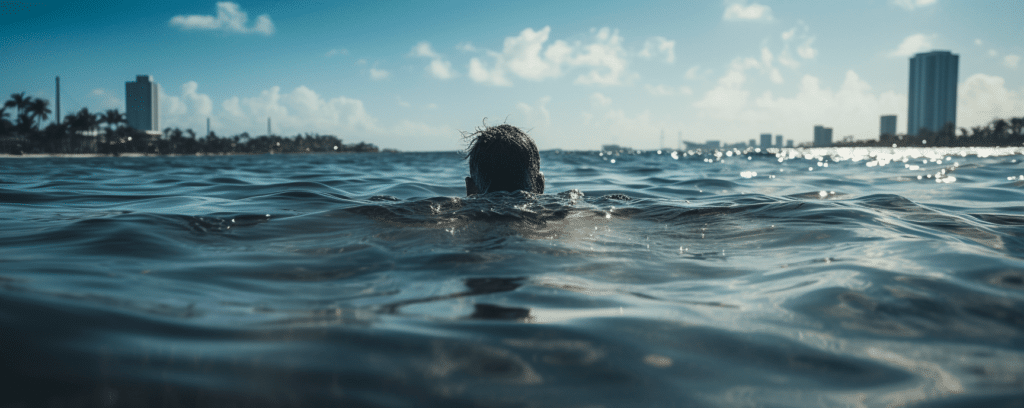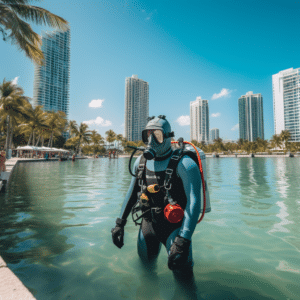
Loss of consciousness most often occurs during which stage of cold water immersion? It is during the long-term immersion stage. This critical moment signifies the body’s extensive exposure to harsh cold conditions. Explore with us the stages of immersion, the physiological effects on the body, and strategies to prevent tragic consequences.
Key Takeaways
- Cold water immersion triggers involuntary physiological responses such as the cold shock response, which can result in gasping, hyperventilation, increased heart rate, and blood pressure, potentially leading to panic, disorientation, and an increased risk of drowning.
- Hypothermia is a critical danger during cold water immersion, causing a rapid drop in body temperature that can lead to systemic organ failure, arrhythmias, and even death, with loss of consciousness typically occurring during the fourth stage after prolonged exposure.
- Preparation, appropriate gear, and self-rescue techniques can significantly improve survival in cold water immersion incidents, with life jackets, thermal protection, and adoption of the Heat Escape Lessening Position (HELP) proving effective in enhancing chances of survival.
Contact us today for your free & confidential case review. Our team will help you get the compensation that you deserve.
The Dangers of Cold Water Immersion
Cold water immersion poses significant, life-threatening risks. It triggers a host of involuntary reactions in the body that can potentially lead to fatal outcomes. This section aims to shed light on these dangers, offering an insight into the physiological responses that occur during cold water immersion and how they can turn individuals into drowning victims.
The most immediate and apparent danger of cold water immersion is hypothermia, a condition that occurs when the body loses heat faster than it can produce it. But that’s not all. Exposure to cold water can also initiate the cold shock response. This reflexive reaction can bring about unforeseen dangers, such as:
- Gasping for breath
- Increased heart rate and blood pressure
- Difficulty in coordinating movements
- Loss of muscle control
- Panic and disorientation
It is important to be aware of these risks and take necessary precautions when in cold water.
Moreover, these physiological responses and impaired swimming ability can notably heighten the risk of drowning in cold water. We will now delve into these risks in more detail.
Hypothermia
Imagine taking an icy plunge and feeling your body temperature drop rapidly. This is hypothermia, a condition characterized by a dangerously low body temperature. As the heat is conducted away from your body 25 times faster in water than in air, your body temperature can decrease rapidly, affecting your vital organs and leading to severe consequences.
Hypothermia during cold water immersion can result in the failure of multiple organ systems such as the neurologic, metabolic, and cardiac systems. In extreme cases, this can lead to fatality. Arrhythmias like atrial fibrillation may also manifest as a result of hypothermia, increasing the risk of sudden cardiac death. Hypothermia can occur within minutes of entering cold water, whether it’s saltwater or freshwater, and its symptoms typically manifest gradually. Some common symptoms of hypothermia include:
- Shivering
- Cold and pale skin
- Slurred speech
- Confusion and poor coordination
- Fatigue and drowsiness
- Weak pulse
- Slow and shallow breathing
If you or someone you know is experiencing these symptoms after being in cold water, it is important to seek medical attention immediately.
The most alarming part is that this rapid loss of body heat can affect your brain cells, which need a constant supply of oxygen to function properly. As hypothermia progresses, it affects cellular metabolism, blood flow, and neural function, potentially leading to irreversible brain damage and eventual death if not treated promptly. Hence, understanding hypothermia and its impact on brain temperature is the first step towards understanding the dangers of cold water immersion.
Cold Shock Response
The cold shock response is your body’s immediate reaction to sudden cold water immersion. It’s a series of involuntary reactions that include gasping, hyperventilation, and increased heart rate, which can lead to accidental death if not managed properly.
In a cold shock response, your body experiences:
- an elevation in respiratory rate
- an elevation in heart rate
- an elevation in blood pressure
- peripheral vasoconstriction, resulting in reduced blood flow

The potential hazards linked to the cold shock response during cold water immersion encompass:
- Gasping
- Uncontrollable hyperventilation
- Elevation of blood pressure
- Risk of heart conditions
- Risk of hypothermia
- Potential for water inhalation, which can lead to unintentional drowning.
The cold shock response can lead to involuntary inhalation, potentially resulting in fatal wet drowning if you are underwater. In some cases, this can also lead to secondary drowning, where water enters the lungs and causes complications after the initial event.
Increased Drowning Risk
Cold water immersion doesn’t just put you at risk of hypothermia; it also increases the risk of fresh water drowning. This risk is primarily attributed to physiological responses such as the shock response and the potential for developing hypothermia in cold water.
Cold water can have a negative effect on your swimming abilities and exercise capacity by lowering your core temperature. As a result, even if you’re a good swimmer, your swimming ability can decrease significantly during cold water immersion, with the loss of basic motor skills occurring after only a few minutes. In this regard, the rate of drowning in cold water is elevated in comparison to warm water.
To prevent a drowning scenario, it is crucial to take necessary precautions such as:
- Wearing a wetsuit or other appropriate cold water gear
- Swimming with a buddy or in a supervised area
- Knowing your limits and not pushing yourself too hard in cold water
- Being aware of the signs of hypothermia and taking immediate action if you or someone else is experiencing them
By following these precautions, you can enjoy swimming in cold water safely at a swimming pool.
Considering that most people don’t expect to fall into cold water suddenly, they’re often unprepared for the sudden loss of motor control, the gasping reflex, and the onset of hypothermia. All these factors can rapidly lead to a drowning person, reinforcing the need for understanding and preparation before engaging in activities involving cold water.
Stages of Cold Water Immersion
Understanding the stages of cold water immersion can help you grasp the progression of physiological responses and potential dangers. From initial immersion to short-term and long-term immersion, each stage presents unique challenges and risks.
The stages of cold water immersion are:
- Initial cold shock stage: characterized by a sudden gasp, rapid breathing, and increased heart rate.
- Short-term immersion stage: the body attempts to adapt to the cold water immersion, involving muscle cooling and decreased swimming ability.
- Long-term immersion stage: leads to hypothermia, loss of consciousness, and potentially, drowning.
Recognize that loss of consciousness usually takes place during or after rescue, in the fourth stage of cold water immersion, after extended exposure. Hence, comprehending each stage and knowing how to manage it is vital.
Initial Immersion
The moment you plunge into cold water, your body immediately reacts. This is the initial immersion phase, characterized by a series of neurogenic cardio-respiratory reactions, including:
- a sudden gasp
- a rapid increase in heart rate
- a decrease in blood pressure
- a constriction of blood vessels in the skin
- a release of adrenaline
- a range of emotional responses such as heightened alertness and attentiveness
Upon initial immersion in cold water, your body undergoes a surge in stress hormones, resulting in a heightened heart rate, subsequent rise in blood pressure, and possibly bradycardia, a decrease in heart rate. This sudden shock to your system can lead to panic, which can make it even more difficult to respond appropriately to the situation.
The onset of panic during the initial immersion in cold water can be attributed to the initial shock, which may lead to hyperventilation and an increased heart rate, ultimately overwhelming you with a sense of panic. This initial immersion phase is crucial as it sets the stage for the subsequent stages of cold water immersion.
Short-term Immersion
Following the initial shock, your body enters the phase of short-term immersion. During this phase, your body continues to struggle to adapt to the cold water. This stage typically lasts for a duration ranging from three to 30 minutes.
During short-term immersion, your body experiences:
- an elevation in respiratory rate
- an elevation in heart rate
- an elevation in blood pressure
- constriction of blood vessels in the limbs
Your muscles start to cool down, potentially diminishing your muscle performance and hastening the onset of fatigue.
This decrease in muscle performance is particularly concerning as it can significantly affect your swimming ability. Indeed, your ability to swim can diminish significantly during short-term immersion in cold water, with the loss of basic motor skills occurring after only a few minutes.
Long-term Immersion and Loss of Consciousness
As your body stays in cold water for a prolonged period, it enters the stage of long-term immersion. This stage is characterized by:
- heightened respiratory rate
- increased heart rate
- elevated blood pressure
- reduced cerebral blood perfusion
Long-term immersion in cold water can lead to hypothermia. As your body’s core temperature decreases, you may experience reduced dexterity and even loss of consciousness. If a rescue is not promptly provided, this stage can have fatal consequences.
It’s crucial to note that the loss of consciousness commonly occurs during or after rescue, in stage 4 of cold water immersion, after prolonged exposure of the body to cold water. This is why it’s so important to rescue a person from cold water as quickly and safely as possible.
Factors Affecting Loss of Consciousness in Cold Water Immersion
While the stages of cold water immersion provide a general progression of the physiological responses, several factors can affect the point at which loss of consciousness occurs. These include water temperature, swimming ability, and clothing, among others.
Water temperature greatly influences the onset of hypothermia and loss of consciousness during cold water immersion. The body’s core temperature can drop as cold water draws heat away, ultimately leading to loss of consciousness and potentially fatal outcomes without timely rescue.
Understanding these factors can help you prepare for and respond appropriately to cold water immersion. Now, let’s explore these factors in more detail.
Water Temperature
The water temperature plays a significant role in the speed at which hypothermia and loss of consciousness occur. The colder the water, the faster your body loses heat, and the sooner the symptoms of hypothermia set in.
It’s important to note that the risk of hypothermia becomes significantly elevated when the water temperature falls below 70 degrees Fahrenheit. Therefore, it’s crucial to check the water temperature before you engage in any activities involving water, especially if you’re planning to be in the water for an extended period.
Moreover, the temperature of the water can result in a decrease in your body’s core temperature when exposed to cold water immersion, potentially leading to loss of consciousness and, in severe cases, death if prompt rescue is not provided. This is why it’s so important to monitor the water temperature and be prepared for the potential effects of cold water immersion.
Swimming Ability and Fitness Level
Swimming ability and fitness level significantly influence your capacity to stay afloat and maintain consciousness during cold water immersion. Cold water can rapidly reduce your swimming prowess and induce muscle fatigue, even if you are an adept swimmer.
Regular swimming training in cold water can enhance tolerance to stress factors, diminish the cold shock response, and promote a greater sense of comfort in cold water, potentially improving survival chances. Moreover, a high level of fitness, particularly from endurance exercises like cold water swimming, may provide advantages during cold water immersion by increasing tolerance to stress factors and possibly reducing muscle soreness.
However, it’s important to note that swimming ability is not a determining factor for survival in cold water immersion incidents, as drowning, not hypothermia, is the primary cause of death. Therefore, while a good swimming ability and fitness level can help, they are not enough to ensure survival in cold water immersion incidents.
Clothing and Protective Gear
Your choice of attire can notably affect your body’s response to cold water immersion. Appropriate clothing and protective gear can assist in delaying the onset of hypothermia and loss of consciousness.
The most effective clothing options for minimizing the risk of hypothermia in cold water include a combination of:
- Long underwear
- Pants/shirts
- Vests
- Jackets
It is advisable to wear layers of loose, warm clothes, with wool being the highly recommended material. Additionally, survival suits and drysuits offer thermal protection by effectively blocking cold water from entering and providing insulation to minimize heat transfer to the surroundings.
Moreover, buoyancy aids in cold water immersion play a crucial role in maintaining the victim’s buoyancy, keeping their head above water, and facilitating rescue operations, thereby reducing the potential for drowning. Therefore, wearing appropriate clothing and protective gear is a key factor in surviving cold water immersion.
Contact us today for your free & confidential case review. Our team will help you get the compensation that you deserve.
Prevention and Survival Strategies
Alongside understanding the risks and stages of cold water immersion, gaining knowledge about prevention and survival strategies is equally vital. These strategies can help reduce the risk and enhance survival prospects during cold water immersion.
Preparation should encompass the following:
- Use a secured personal flotation device (PFD)
- Wear layered clothing for insulation
- Acclimate the body to cold through regular cold showers or immersion in cold water
- Wear thermal protection such as a wetsuit or drysuit to mitigate the risks of cold water immersion.
In addition to wearing appropriate gear, there are specific self-rescue techniques that you can employ during cold water immersion. These techniques include wearing a lifejacket or PFD and assuming the ‘HELP’ or Heat Escape Lessening Posture as effective self-rescue techniques. Now, let’s explore these strategies in more detail.
Preparing for Cold Water Activities
Preparation for cold water activities requires comprehension of the risks, monitoring weather conditions, and communicating your plans to others. Sharing your plans is essential as cold water, even when it doesn’t seem very cold, can pose a risk of conditions such as hypothermia, which can prove to be deadly.
Examining weather conditions is crucial for preparing for cold water activities as it offers insights into the water temperature and possible dangers, enabling individuals to dress suitably and be ready for the conditions. When assessing the risk level for cold water activities, it is important to consider factors such as water temperature, the type of activity being performed, and the presence of others familiar with the area. Additionally, it is crucial to be mindful that a person’s core temperature can continue to drop to dangerous levels even after leaving the cold water.
In essence, proper preparation for cold water activities requires a good understanding of the inherent risks, the necessary precautions, and a readiness to respond to emergencies. It’s always better to be safe than sorry when it comes to activities involving cold water.
Wearing Appropriate Gear

The most suitable types of gear for cold water immersion include:
- Swimwear
- Wetsuits
- Swimming changing robes and coats
- Swimming socks
- Neoprene caps or wooly hats
- Thermal rash vests
These gear options provide thermal protection and help retain body heat. Wearing a drysuit in cold water also provides thermal protection, allows for diving in cold water destinations, enhances diving skillset and knowledge, and broadens diving experiences.
Life jackets play a crucial role in reducing the risk of sudden drowning caused by cold shock and swimming failure. They also assist in preventing a cold water drowning victim from sinking, aiding in body recovery. Therefore, wearing appropriate gear is a crucial factor in surviving cold water immersion incidents.
Self-Rescue Techniques
Beyond preparation and appropriate gear, leveraging specific self-rescue techniques during cold water immersion can prove beneficial. These methods can enhance your survival chances and help you remain safe until rescue arrives.
The Heat Escape Lessening Position (HELP) is a self-rescue technique specifically developed to minimize heat loss when an individual is submerged in cold water. It supports cold water survival by offering protection to crucial areas of the body, such as:
- the head
- the neck
- the sides of the chest cavity
- the groin.
Another effective self-rescue technique during cold water immersion is huddling with others. Huddling with others in the water serves to:
- Minimize the collective loss of body heat among individuals
- Enhance the likelihood of survival in cold water
- Provide morale support, which can be advantageous in survival scenarios.
Real-Life Cold Water Immersion Stories
To underscore the dangers and emphasize the importance of adequate preparation and gear, we will examine some real-life cold water immersion incidents. These stories offer valuable insights into the experiences of individuals who have encountered this perilous situation.
Consider the documented instances of a woman who survived for several hours in cold water after her boat capsized and a 2-year-old girl who was submerged in iced water for 66 minutes but survived. Some survivors attribute their survival to wearing appropriate gear, and there are cases of individuals enduring prolonged submersion with minimal neurological damage.
Prominent individuals who have gained prominence for surviving incidents of cold water immersion include Anna Bågenholm and John Hayward. These stories underscore the importance of understanding the dangers associated with cold water immersion and the necessity of proper preparation and gear.
It’s also worth noting that the primary cause of death for crew members of the Titanic was immersion hypothermia, not drowning. This highlights the critical nature of hypothermia in cold water survival situations, where victims can remain afloat for extended periods if not rescued, leading to preventable death.
Frequently Asked Questions
During which stage of cold water immersion does loss of consciousness occur?
Loss of consciousness occurs during Stage 3 of cold water immersion, when the body’s core temperature drops, leading to hypothermia, and ultimately, death. Stage 4, or post-immersion collapse, can also occur during or after rescue.
What are the 4 phases of cold water immersion?
The four phases of cold water immersion are: initial immersion responses or cold shock, short-term immersion or swimming failure, long-term immersion or hypothermia, and post-rescue collapse. It’s important to recognize these stages for safety in cold water.
What are the physiological mechanisms that lead to the occurrence of hypothermia during cold water immersion?
The occurrence of hypothermia during cold water immersion is caused by peripheral vasoconstriction, reduced blood flow, slowed respiration, and decreased deep body temperature, all of which affect cellular metabolism and neural function. These physiological mechanisms lead to a reduced oxygen supply to vital organs.
What measures need to be undertaken to adequately prepare for activities involving cold water?
To adequately prepare for activities involving cold water, it’s important to use a secured personal flotation device (PFD), wear layered clothing for insulation, and consider acclimating your body to cold through regular cold showers or immersion in cold water. These measures can help increase safety and minimize the risks associated with cold water activities.
What type of gear is advisable for mitigating the risks of cold water immersion?
To mitigate the risks of cold water immersion, it is advisable to wear thermal protection such as a wetsuit or drysuit, along with immersion suits, survival suits, and other protective gear for warmth and safety.
Last updated Monday, July 22nd, 2024









